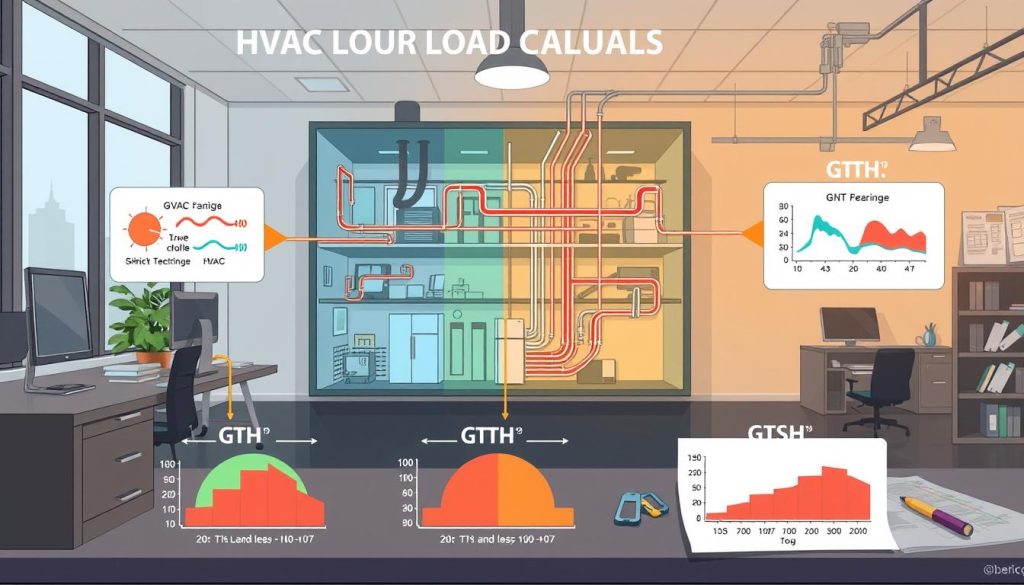In the HVAC world, “GTH” means “Grand Total Heat.” It’s used to talk about the cooling power of air handling units (AHUs). Knowing what GTH and GTSH mean is key to picking the right HVAC gear for a building.
GTH shows the total cooling power of an HVAC system. It includes both sensible heat and latent heat. This total cooling power is vital for keeping a space’s temperature and humidity just right, in homes, offices, or factories.
Geothermal heating and ground-source heat pumps are getting more popular. They’re good for the planet and save energy. Knowing HVAC terms like GTH and GTSH helps people choose the best HVAC for their needs.
Key Takeaways
- GTH stands for “Grand Total Heat” and is a term used in HVAC to describe the total cooling capacity of an air handling unit.
- GTH includes both sensible heat and latent heat, providing a comprehensive measure of the system’s ability to cool and dehumidify a space.
- Understanding GTH and related HVAC terminology is crucial for properly sizing and selecting HVAC equipment to meet the specific requirements of a building.
- Geothermal heating and other renewable energy HVAC systems are becoming more popular, and knowledge of HVAC terminology is valuable for homeowners and professionals alike.
- Properly calculating GTH and GTSH values is essential for ensuring the HVAC system can effectively manage temperature and humidity levels in a given space.
Introduction to GTH in HVAC
Knowing HVAC terminology is key when picking the right gear and designing HVAC systems. GTH, or Gross Total Heat, is a vital term in HVAC design. It shows the total heat an HVAC component or system must manage.
Importance of Understanding HVAC Terminology
HVAC systems are complex, with many parts and technical details. Learning common HVAC terminology helps you understand how these systems work. This knowledge is crucial for making smart choices in HVAC design and picking the right equipment.
Overview of Air Handling Units (AHUs)
Air handling units (AHUs) are at the core of many HVAC systems. They handle tasks like circulating, cleaning, heating, cooling, humidifying, and dehumidifying air. AHUs vary in size and design, from small units to large custom ones. They are essential for keeping indoor spaces comfortable.
| HVAC Component | Function |
|---|---|
| Air Handling Unit (AHU) | Circulates, cleans, heats, cools, humidifies, and dehumidifies air |
| Furnace | Heats air and distributes it through the ductwork |
| Air Conditioner | Cools and dehumidifies air |
| Thermostat | Controls the temperature and humidity of the indoor environment |
What does GTH Mean in HVAC?
In HVAC, “GTH” means “Grand Total Heat.” It’s key to knowing how much heat an air handling unit (AHU) or HVAC system can handle. The GTH value shows the total heat, including both sensible and latent heat, that the system can manage.
Understanding GTH is vital for picking the right HVAC equipment. It helps ensure the system can cool and dehumidify a building properly. This value is usually in kilowatts (kW) or British Thermal Units (BTUs) per hour, showing the system’s cooling power.
Importance of Understanding HVAC Terminology
Knowing HVAC terms like GTH is crucial for HVAC pros, building owners, and anyone working with these systems. It helps pick, install, and run the right equipment. This ensures comfort and energy savings in buildings.
Overview of Air Handling Units (AHUs)
Air handling units (AHUs) are central to HVAC systems. They spread cooled or heated air in buildings. The GTH value is important for AHUs, showing their cooling power and heat management.
| HVAC Specification | Description | Example Value |
|---|---|---|
| GTH (Grand Total Heat) | The total cooling capacity of an HVAC system, including both sensible and latent heat | 50 kW or 170,000 BTU/hr |
| HVAC Cooling Capacity | The maximum amount of heat an HVAC system can remove from a space | 40 kW or 135,000 BTU/hr |
| HVAC Terminology | The specialized language and definitions used in the HVAC industry | N/A |
| HVAC Specifications | The technical details and performance characteristics of HVAC equipment | N/A |
By grasping the GTH meaning in HVAC, you can make sure your system fits your building’s needs. This leads to better comfort and energy use.
Difference Between GTH and GTSH
Understanding the difference between GTH (Gross Total Heat) and GTSH (Gross Sensible Heat) is key for HVAC system design. GTH is the total cooling capacity, including sensible heat and latent heat. GTSH, however, is the sensible cooling capacity. This is the heat that changes the air temperature.
Sensible Heat and Latent Heat
Sensible heat changes the air temperature directly. Latent heat is about the moisture in the air. Finding the right balance between these two is important for comfort and system efficiency.
Significance of SHR (Sensible Heat Ratio)
The Sensible Heat Ratio (SHR) shows the balance between sensible and total heat in HVAC systems. It helps ensure the system keeps the air comfortable. A higher SHR means more focus on temperature, while a lower SHR means more on humidity control.
| Characteristic | GTH (Gross Total Heat) | GTSH (Gross Sensible Heat) |
|---|---|---|
| Definition | Total cooling capacity, including sensible and latent heat | Sensible cooling capacity, the heat that can be felt and measured by a temperature change |
| Measurement | Btu/h (British Thermal Units per hour) | Btu/h (British Thermal Units per hour) |
| Significance | Determines the overall cooling requirements of the HVAC system | Helps maintain comfortable indoor temperature and humidity levels |
Calculating GTH and GTSH Values
Figuring out the Gross Total Heat (GTH) and Gross Total Sensible Heat (GTSH) values is key in HVAC design. It looks at many things like building size, materials, and climate. These help estimate how much cooling and sensible cooling the building needs.
Cooling Load Calculations
Calculating the cooling load means looking at the heat in and out of the building. This includes:
- Building size and shape
- Materials and insulation
- Solar radiation through windows and walls
- Heat from people, lights, and machines
- Outdoor weather, humidity, and climate
By looking at these, HVAC experts can find the total cooling load. This is important for picking the right HVAC equipment. It helps keep the building comfortable.
Airflow and Static Pressure Considerations
The HVAC design also looks at airflow and static pressure. Finding the right airflow is key for spreading air well. Static pressure helps make sure the air handling unit and ducts are the right size.
By calculating GTH, GTSH, airflow, and static pressure, HVAC pros can create an efficient system. It keeps the building comfortable and meets its needs.

Applications of GTH and GTSH in HVAC Design
In HVAC design, knowing GTH (Gross Total Heat) and GTSH (Gross Total Sensible Heat) is key. These values help size HVAC equipment right. This ensures the system works well and efficiently.
Proper Sizing of HVAC Equipment
Finding the right GTH and GTSH values is vital for picking the correct HVAC size. If the equipment is too big, it wastes energy. If it’s too small, it can’t keep the space cool and dry. Designers use these values to pick the best equipment for the job.
When sizing HVAC equipment, designers look at a few things:
- Cooling load calculations: They figure out how much heat the building needs to cool.
- Airflow and static pressure: They check if the system can move air well enough.
- Equipment selection: They choose the right parts, like air handling units and condensing units.
Using GTH and GTSH in the design helps make the system more efficient. This means better comfort for people inside and lower energy bills.
Psychrometric Analysis and GTH/GTSH
Psychrometric analysis is key for HVAC designers. It uses the psychrometric chart to find GTH (Gross Total Heat) and GTSH (Gross Total Sensible Heat) values. The chart shows the properties of moist air, helping engineers understand HVAC processes.
By knowing these processes, HVAC pros can design systems better. This improves indoor air quality and energy use.
Psychrometric Chart and Processes
The psychrometric chart is a powerful tool. It lets HVAC designers see how moist air changes during HVAC processes. By looking at air’s temperature and humidity, they can find GTH and GTSH values.
These values are crucial for HVAC system performance and design.
- The chart shows how air temperature, humidity, and other properties relate.
- It helps designers see the effects of heating, cooling, humidification, and dehumidification.
- By analyzing the chart, HVAC pros can make better choices about equipment and energy efficiency.
| Psychrometric Process | Description | Impact on GTH/GTSH |
|---|---|---|
| Sensible Heating | Increases air temperature without changing moisture | Increases GTSH, but GTH stays the same |
| Sensible Cooling | Decreases air temperature without changing moisture | Decreases GTSH, but GTH stays the same |
| Humidification | Adds moisture to air without changing temperature | Increases GTH, but GTSH stays the same |
| Dehumidification | Removes moisture from air without changing temperature | Decreases GTH, but GTSH stays the same |
Energy Efficiency and GTH/GTSH
The values of Gross Total Heat (GTH) and Gross Total Sensible Heat (GTSH) are key in HVAC system performance. They help balance sensible and latent cooling loads. This balance optimizes system performance and cuts down energy use.
Understanding these values helps HVAC designers save energy and lower costs. This is vital for HVAC energy efficiency. Even small improvements can greatly reduce long-term costs and environmental impact.
How do GTH and GTSH affect HVAC energy efficiency?
GTH and GTSH values affect HVAC equipment sizing and selection. If not balanced, systems may run inefficiently, using more energy. By optimizing these values, designers ensure equipment is sized right, working at its best HVAC system performance.
What strategies can be used to improve HVAC energy efficiency based on GTH and GTSH?
HVAC designers can use several strategies to boost energy efficiency. These include:
- Choosing the right HVAC equipment size for the building’s cooling needs
- Optimizing airflow and static pressure for efficient system operation
- Using variable-speed compressors and fans to adjust output as needed
- Implementing advanced controls and sensors for real-time system adjustments
These HVAC optimization techniques help make systems more energy-efficient. This reduces operating costs for building owners or occupants.
How can GTH and GTSH data be used to improve HVAC design?
Understanding GTH and GTSH values is essential in HVAC design. Designers use this data to:
- Size HVAC equipment accurately for the building’s cooling needs
- Determine necessary ductwork and airflow
- Choose energy-efficient components like compressors and fans
- Optimize control strategies for better comfort and less energy use
By using GTH and GTSH data, designers create systems that are both comfortable and energy-efficient. This benefits both the building owner and the environment.
| Parameter | Impact on Energy Efficiency |
|---|---|
| GTH | Higher GTH values may indicate a need for larger HVAC equipment, leading to increased energy consumption. Optimizing GTH can improve system efficiency. |
| GTSH | Higher GTSH values suggest a greater sensible cooling load, which may require more energy-intensive equipment. Balancing GTSH can enhance energy performance. |
Challenges and Considerations
Working with GTH (Gross Total Heat) and GTSH (Gross Total Sensible Heat) in HVAC design comes with its own set of challenges. The climate and regional characteristics of the project location are key factors. They can greatly affect how well your HVAC system performs.
Adapting to Climate Conditions
In hot and humid areas, the need to remove moisture from the air is more pressing. This means a lower SHR (Sensible Heat Ratio) and more focus on dehumidification. On the other hand, in dry climates, cooling the air to lower temperatures is more important. HVAC designers must carefully balance GTH and GTSH based on the climate.
Considering Regional Factors
Regional factors also play a big role in HVAC design. Building codes, local regulations, and cultural preferences can all impact the design. HVAC designers need to stay up-to-date with these regional requirements to ensure their designs meet local standards and user needs.
Understanding climate and regional challenges helps HVAC professionals make better choices. They can pick the right equipment and design efficient systems that meet client needs. This knowledge is essential for delivering top-notch HVAC solutions across different environments.

Industry Standards and Best Practices
In the HVAC industry, keeping high standards is key. This ensures systems work well, safely, and efficiently. The American Society of Heating, Refrigerating and Air-Conditioning Engineers (ASHRAE) sets HVAC industry standards and HVAC design guidelines. These help professionals design systems right, including using GTH and GTSH correctly.
Following HVAC best practices helps designers and installers meet HVAC regulations. This leads to energy-saving systems that make buildings comfortable and healthy for people inside.
Key Industry Standards and Guidelines
- ASHRAE Standard 62.1: Ventilation for Acceptable Indoor Air Quality
- ASHRAE Standard 90.1: Energy Standard for Buildings Except Low-Rise Residential Buildings
- ASHRAE Handbook: Fundamentals, HVAC Applications, HVAC Systems and Equipment, and Refrigeration
- ACCA Manual J: Residential Load Calculation
- ACCA Manual D: Duct Design
- ACCA Manual S: Residential Equipment Selection
These standards and guidelines offer detailed advice. They help with cooling load calculations, airflow needs, and choosing the right HVAC equipment. This ensures systems are safe, efficient, and meet performance needs.
| Standard/Guideline | Focus Area |
|---|---|
| ASHRAE Standard 62.1 | Ventilation and indoor air quality |
| ASHRAE Standard 90.1 | Energy efficiency in building design |
| ASHRAE Handbook | Comprehensive HVAC design and application guidance |
| ACCA Manual J | Residential cooling and heating load calculations |
| ACCA Manual D | Duct system design and sizing |
| ACCA Manual S | Residential HVAC equipment selection |
By sticking to HVAC industry standards and HVAC best practices, HVAC pros can make sure their work is top-notch. They deliver systems that save energy and make buildings comfortable and healthy for everyone.
Conclusion
Understanding GTH (Grand Total Heat) and GTSH (Grand Total Sensible Heat) is key for HVAC pros. These terms show the total and sensible cooling capacities. Knowing them helps ensure the HVAC system meets the building’s needs well.
Using industry standards and psychrometric analysis, HVAC designers can improve system balance. This leads to energy-efficient systems that make indoor spaces comfortable. Your HVAC design will meet the building’s needs, saving energy and keeping you competitive.
Learning about GTH and GTSH is vital for HVAC pros. It helps you design systems that save energy and improve comfort. With this knowledge, you can create HVAC systems that exceed your clients’ expectations.





0 Comments